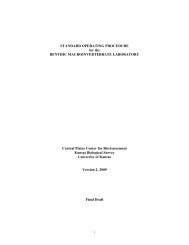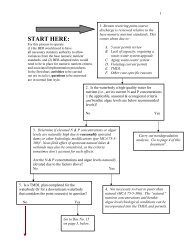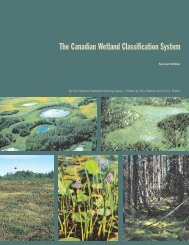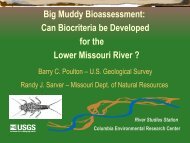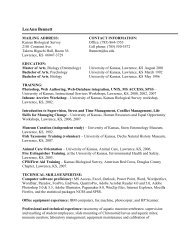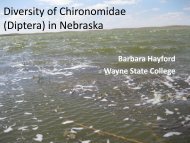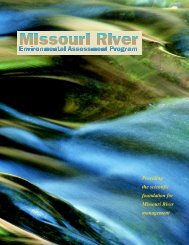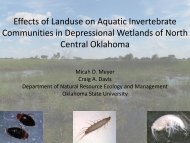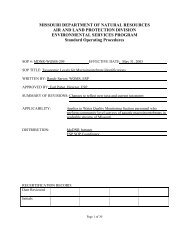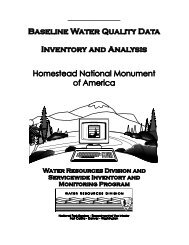Koontz, J., D.G. Huggins, C.C. Freeman, D.S. Baker - Central Plains ...
Koontz, J., D.G. Huggins, C.C. Freeman, D.S. Baker - Central Plains ...
Koontz, J., D.G. Huggins, C.C. Freeman, D.S. Baker - Central Plains ...
You also want an ePaper? Increase the reach of your titles
YUMPU automatically turns print PDFs into web optimized ePapers that Google loves.
wetlands, respectively. Macroinvertebrate collections were obtained from 54 sites, but the<br />
exclusion of one outlier (site 7108) reduced the number to 53, with 16 samples from Phase I and<br />
37 samples from Phase II. Because disturbance assessment data were used in the<br />
macroinvertebrate selection process in developing a multiple metric index, one Phase I sample<br />
(7107) was excluded during the MMI development process because this information was not<br />
available. Because disturbance assessment information was used in development of the multiple<br />
metric index (MMI), only 52 sites were used in developing the MMI but all 54 samples were<br />
scored.<br />
Floristic Quality Assessment Results<br />
No significant differences were found between Phase I and Phase II sample populations when<br />
ANOVA and Tukey-Kramer multiple comparison test were performed on the FQI and Native<br />
plant FQI scores. However, significant differences (p = 0.001) in variance and mean total<br />
richness and native richness were found between the two study groups. Total plant richness<br />
mean value for reference sites was 41.05 (STDERR = 14.39) and 3.14 (STDERR = 2.34) for the<br />
random sites. Native plant richness mean value for reference sites was 36.10 (STDERR = 2.68)<br />
and 23.76 (STDERR = 2.00) for the random sites. Mean conservatism was also found to be<br />
significantly different between reference and random, with 3.64 (STDERR = 0.17) for the<br />
random population and 3.07 (STDERR = 0.17) for the reference population. A similar trend was<br />
seen in the measure of native mean conservatism where the random population had a<br />
significantly (p = 0.014) higher sample mean (4.05, STDERR = 0.15) than the reference<br />
population (3.44, STDERR = 0.16). Mean percent adventive species values were not<br />
significantly different between the two wetland populations. Further evaluation efforts in higher<br />
order delineation of sites should consider these groups separately.<br />
ANOVA and Tukey-Kramer multiple comparison tests were performed using all study sites to<br />
examine possible differences associated with sample year. In the random population, mean FQI<br />
was statistically higher (p = 0.04) in 2009 (n = 10, mean FQI = 19.65, STDERR = 1.33) than in<br />
2008 (n = 32, mean FQI = 16.41). No significant differences in FQI were found between 2005<br />
and 2009. ANOVA testing of FQI scores for 2005 and 2008 samples showed significant yearly<br />
differences (p = 0.04) in FQI values. When all years were compared again using one-way<br />
ANOVA and Tukey-Kramer comparison tests, significant yearly differences were again noted (p<br />
= 0.03), though the post hoc comparison test did not clearly indicate group separations. ANOVA<br />
test using only the randomly selected wetland data indicated that the mean Native FQI values<br />
were significantly different (p = 0.02) between 2008 (17.34, STDERR = 0.72) and 2009 (20.83,<br />
STDERR = 1.29). When 2005 and 2008 were evaluated without 2009, significant yearly<br />
differences in were found with 2005 having a mean value of 19.99 (STDERR = 0.9); but when<br />
2008 was excluded from analysis, 2005 and 2009 values were not significantly different from<br />
each other (p = 0.62). This further suggests that 2009 plant community samples were similar to<br />
those collected in 2005. It remains unclear if yearly conditions affected the FQI metric or if<br />
differences were merely serendipity. Overall, the wetlands in both study phases appear to exist<br />
on a continuum of floristic conditions as indicated by the overlapping FQI scores between and<br />
among collection years.<br />
The CDFs for both the reference and random wetland groups were similar, but the CDF for<br />
reference wetlands indicated that most all of scores were above those of the random population<br />
31 of 84



